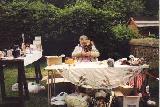|
 
Money has to be raised both to keep the building in good repair, and to contribute as much as £6,000 a year to help pay for the Rector and other administrative costs of the Diocese. In essence, the Parochial Church Council has to find about £120 from every household in the parish (about 95), explained treasurer Andrew Kedar. One of the biggest costs is the annual insurance premium. "We're insured for about £450,000 and this year's premium payment was £745 - quite a lot of money to find," he said. The real value of the building is a lot higher, but the £450,000 would create a building adequate in size to cater for the village. The building is inspected by an architect every five years who then specifies work to be done to preserve the Grade II building in good repair. "We've just completed last year, in 1998, about £19,000 worth of repairs which so far we have paid for ourselves. But towards the end of last year we were given a grant by the Suffolk Historic Churches Trust of £3,000 and this of course will go towards the work." Subsidies are not generally available, added Andrew. Another inspection is now due. "There will be another whole pile of jobs to do to put the church right as far as the architect is concerned." "We also have heating costs, lighting costs, wine and wafers, and there are always little repair jobs - lots and lots of little repair jobs apart from the big five yearly stint of repairs." A further burden is that the full value added tax of 17.5% has to be paid on the work in the church and the churchyard. "We always think this is a shame, because we are preserving a historic building." Just a handful of folks supporting the church have to sustain the wonderful, classical building, he stressed.
|
|
|
Tea and cakes are on sale in the churchyard every Sunday in summer, as they have been since 1974. This is done to raise money for the church, and 1999 was a particularly successful year. "We have - along with donations given to us - raised almost £850 by the teas," said Andrew Kedar. Refreshments aren't all that is on sale. Thelma Thompson has a stall just outside the church. "Bric-a-brac is given to her - books, and brass and all kinds of things, to sell at the church," explained Andrew. She made over £400 in 1999, and together with proceeds from a coffee morning, her total was almost £580. "Our average in past years has been around £1,000, from teas and Thelma's stall," said Andrew. There are wall boxes in the church for visitors who wish to help. "This year in the wall box we will probably receive between about £300 and £400, which is an excellent help - I am also the treasurer!" said Andrew. There have also been occasional flower festivals, mainly to raise money, but also to encourage people to come into church. Then there is carol singing. "On two nights before Christmas - hopefully with good weather - we go round the village trying to visit each house carol singing," said Margaret. "The money that we raise is given to St Mary's, mainly for the preservation of the building." The carol service in the church also acts as a fund raising day - there may be 100 people there - the average attendance for a Sunday service is about 21 or 22.
|
|
|
The churchgoers also raise money for charities, in addition to finding the funds they need to run St Mary's. The harvest festival service - when people give the usual harvest produce - is followed by a harvest supper. "We move a bit of furniture around and we manage to seat around 40-45 people and we have the supper where people produce goodies to eat," explained Margaret Kedar. "This year we raised in the one evening just over £300 which we sent to the Red Cross, following the Turkey earthquake." The other main charity that the church supports is the Children's Society. Each year there is a house to house collection, and people keep boxes in their houses throughout the year. "Over the last 10 years we have raised about £2500 for the Children's Society," said Margaret.
|
|
|
|
|
|
|
|
|
|
|
|
|
Copyright 2016 TJKSoftware,Icehouse Media, ~ designed & maintained by
TJKSoftware

